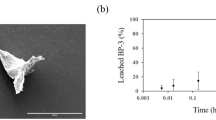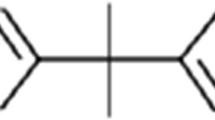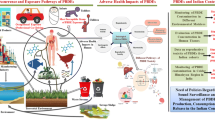Abstract
Bisphenol A (BPA) is an endocrine disrupting chemical (EDC) whose migration from food packaging is recognized worldwide. However, the real overall food contamination and related consequences are yet largely unknown. Among humans, children’s exposure to BPA has been emphasized because of the immaturity of their biological systems. The main aim of this study was to assess the reproductive impact of BPA leached from commercially available plastic containers used or related to child nutrition, performing ecotoxicological tests using the biomonitoring species Daphnia magna. Acute and chronic tests, as well as single and multigenerational tests were done. Migration of BPA from several baby bottles and other plastic containers evaluated by GC-MS indicated that a broader range of foodstuff may be contaminated when packed in plastics. Ecotoxicological test results performed using defined concentrations of BPA were in agreement with literature, although a precocious maturity of daphnids was detected at 3.0 mg/L. Curiously, an increased reproductive output (neonates per female) was observed when daphnids were bred in the polycarbonate (PC) containers (145.1 ± 4.3 % to 264.7 ± 3.8 %), both in single as in multigenerational tests, in comparison with the negative control group (100.3 ± 1.6 %). A strong correlated dose-dependent ecotoxicological effect was observed, providing evidence that BPA leached from plastic food packaging materials act as functional estrogen in vivo at very low concentrations. In contrast, neonate production by daphnids cultured in polypropylene and non-PC bottles was slightly but not significantly enhanced (92.5 ± 2.0 % to 118.8 ± 1.8 %). Multigenerational tests also revealed magnification of the adverse effects, not only on fecundity but also on mortality, which represents a worrying trend for organisms that are chronically exposed to xenoestrogens for many generations. Two plausible explanations for the observed results could be given: a non-monotonic dose–response relationship or a mixture toxicity effect.




Similar content being viewed by others
References
Alexander HC, Dill DC, Smith LW, Guiney PD, Dorn P (1988) Bisphenol A: acute aquatic toxicity. Environ Toxicol Chem 7(1):19–26
Ashauer R, Boxall ABA, Brown CD (2006) Predicting effects on aquatic organisms from fluctuating or pulsed exposure to pesticides. Environ Toxicol Chem 25(11):1899–1912
ASTM (2004) American Society for Testing Materials. Standard Guide for Conducting Daphnia magna. Life Cycle Toxicity Tests. E1193-97
ASTM (2008) American Society for Testing Materials. Standard practice for conducting toxicity tests with fishes, microinvertebrates and amphibians. In: Annual Book of ASTM Standards; Water and Environmental Technology, vol. 11.04; ASTM E729–96 (2007) American Society for Testing and Materials, Philadelphia, PA
Baird DJ, Soares AMVM, Girling A, Barber I, Bradley M, Callow P (1989) The long-term maintenance of Daphnia magna straus for use in ecotoxicity tests: problems and prospects. In: Lokke H, Tyle H, Bro-Rasmussen F, editor. First European Conference on Ecotoxicology, Lyngby: 144–148
Barata C, Baird DJ, Nogueira AJ, Soares AM, Riva MC (2006) Toxicity of binary mixtures of metals and pyrethroid insecticides to Daphnia magna Straus. Implications for multi-substance risks assessment. Aquat Toxicol 78(1):1–14
Brennan SJ, Brougham CA, Roche JJ, Fogarty AM (2006) Multi-generational effects of four selected environmental oestrogens on Daphnia magna. Chemosphere 64(1):49–55
Canada Environment. Consultation Document: Phenol, 4,4′-(1-Methylethylidene)bis-(Bisphenol A) (2009) Chemical Abstracts Service Registry Number 80-05-7
Caspers N (1998) No estrogenic effects of bisphenol A in Daphnia magna STRAUS. Bull Environ Contam Toxicol 61(2):143–148
Cunha SC, Fernandes JO (2010) Quantification of free and total bisphenol A and bisphenol B in human urine by dispersive liquid–liquid microextraction (DLLME) and heart-cutting multidimensional gas chromatography–mass spectrometry (MD–GC/MS). Talanta 83(1):117–125
De Coensel N, David F, Sandra P (2009) Study on the migration of bisphenol-A from baby bottles by stir bar sorptive extraction-thermal desorption-capillary GC-MS. J Sep Sci 32(21):3829–3836
EC, European Commission (2010) European Union Risk Assessment Report, CAS: 80-05-7 EINECS No: 201-245-8. Environment Addendum of April 2008. 4,4'-isopropyldenediphenol (Bisphenol-A) Part 1 Environment. Joint Research Centre, Institute for Health and Consumer Protection
EC, European Commission (2011) Commission Directive 2011/8/EU of 28 January 2011 amending Directive 2002/72/EC as regards the restriction of use of Bisphenol A in plastic infant feeding bottles. Off J Eur Union L26:11–14
EFSA, European Food Safety Authority (2012) Food Contact Materials, Bisphenol A, http://www.efsa.europa.eu/en/topics/topic/bisphenol.htm?wtrl=01, accessed May 2012
Ehrlich S, Williams PL, Missmer SA, Berry KF, Petrozza J, Hauser R (2011) Urinary bisphenol A and implantation failure among women undergoing in vitro fertilization. Fertil Steril 96(3):S6–S7
Erler C, Novak J (2010) Bisphenol A exposure: human risk and health policy. J Pediatr Nurs 25(5):400–407
EU, European Union (2003) European Union Risk Assessment Report. 4,4′ Isopropylidenediphenol (Bisphenol-A), EINECS No: 201-245-8. Final Report, United Kingdom
González-Castro MI, Olea-Serrano MF, Rivas-Velusco AM, Medina-Rivero E, Ordoñez-Acevedo LG, De Léon-Rodriguez A (2011) Phthalates and bisphenols. Migration in Mexican food cans and plastic food containers. Bull Environ Contam Toxicol 86:627–631
Guart A, Bono-Blay F, Borrell A, Lacorte S (2011) Migration of plasticizers phthalates, bisphenol A and alkylphenols from plastic containers and evaluation of risk. Food Addit Contam Part A Chem Anal Control Expo Risk Assess 28(5):676–685
EURACHEM Guide (1998) The fitness for purpose of analytical methods. Laboratory guide to method validation and related topics. Teddington, United Kingdom
ICH, International Conference on Harmonisation (1994) Validation of analytical methods definitions and terminology, Q2A Guideline
ICH, International Conference on Harmonisation (1995) Validation of analytical procedures: definitions and terminology (CPMP/ICH/381/95) Q2A and Methodology (CPMP/ICH/281/95) Q2B
ICH, International Conference on Harmonisation (2005) Harmonised tripartite guideline. Validation of analytical procedures: text and methodology Q2(R1)
ISO, International Organization for Standardization 6341 (2010) Water quality—determination of the inhibition of the mobility of Daphnia magna Straus (Cladocera, Crustacea)—acute toxicity test
Kortenkamp A, Martin O, Faust M, Evans R, McKinlay R, Orton F, Rosivatz E (2011) State of the art assessment of endocrine disrupters. Final Report. Project Contract Number 070307/2009/550687/SER/D3
Kortenkamp A, Evans R, Martin O, McKinlay R, Orton F, Rosivatz E (2012) State of the art assessment of endocrine disrupters. Final Report. Project Contract Number 070307/2009/550687/SER/D3 Annex 1, Summary of the state of the science. Revision version of the draft published in June 2011 by the European Commission, DG Environment
Kubwabo C, Kosarac I, Stewart B, Gauthier BR, Lalonde K, Lalonde PJ (2009) Migration of bisphenol A from plastic baby bottles, baby bottle liners and reusable polycarbonate drinking bottles. Food Addit Contam 26(6):928–937
Loureiro S, Svendsen C, Ferreira AL, Pinheiro C, Ribeiro F, Soares AM (2010) Toxicity of three binary mixtures to Daphnia magna: comparing chemical modes of action and deviations from conceptual models. Environ Toxicol Chem 29(8):1716–1726
Maia J, Cruz JM, Sendon R, Bustos J, Sanchez JJ, Paseiro P (2009) Effect of detergents in the release of bisphenol A from polycarbonate baby bottles. Food Res Int 42(10):1410–1414
Mansilha C, Melo A, Rebelo H, Ferreira IMPLVO, Pinho O, Domingues V, Pinho C, Gameiro P (2010) Quantification of endocrine disruptors and pesticides in water by gas chromatography-tandem mass spectrometry. Method validation using weighted linear regression schemes. J Chromatogr A 1217:6681–6691
Mansilha C, Rocha S, Gameiro P, Pinho C, Ferreira IMPLVO, Silva P, Domingues V (2012) Interlaboratory validation of an environmental monitoring method for trace analysis of endocrine disrupting compounds. Anal Methods. doi:10.1039/C2AY25450F
Meeker JD, Ehrlich S, Toth TL, Wright DL, Calafat AM, Ye X, Trisini AT, Hauser R (2010) Semen quality and sperm DNA damage in relation to urinary bisphenol A among men from an infertility clinic. Reprod Toxicol 30(4):532–539
Miller JN, Miller JC (2005) Statistics and chemometrics for analytical chemistry, 5th edn. Pearson Education Limited, England
Mu X, Rider CV, Hwang GS, Hoy H, LeBlanc GA (2005) Covert signal disruption: anti-ecdysteroidal activity of bisphenol-A involves cross talk between signaling pathways. Environ Toxicol Chem 24(1):146–152
Nam SH, Seo YM, Kim MG (2010) Bisphenol A migration from polycarbonate baby bottle with repeated use. Chemosphere 79(9):949–952
National Research Council (2008) Phthalates and cumulative risk assessment: the task ahead. National Academies Press, Washington
NCCLS, National Committee for Clinical Laboratory Standards (2002) Approved Guideline, C43-A. Gas Chromatography/Mass Spectrometry (GC/MS) Confirmation of Drugs
NCCLS, National Committee for Clinical Laboratory Standards (2004) Approved guideline, EP17-A. Protocols for Determination of Limits of Detection and Limits of Quantitation
Regulation (EC) No 1107/2009 of the European Parliament and of the Council of 21 October 2009, concerning the placing of plant protection products on the market and repealing Council Directives 79/117/EEC and 91/414/EEC
Regulation (EC) No 1907/2006 of the European Parliament and of the Council of 18 December 2006, concerning the Registration, Evaluation, Authorisation and Restriction of Chemicals (REACH), establishing a European Chemicals Agency, amending Directive 1999/45/EC and repealing Council Regulation (EEC) No 793/93 and Commission Regulation (EC) No 1488/94 as well as Council Directive 76/769/EEC and Commission Directives 91/155/EEC, 93/67/EEC, 93/105/EC and 2000/21/EC
OECD, Organisation for Economic Co-operation and Development (1984) Daphnia sp., acute immobilisation test and reproduction test. In: Part I—the 24 h EC 50 Acute Immobilisation Test
OECD, Organisation for Economic Co-operation and Development (2004) Guidelines for testing of chemicals. Test No. 202: Daphnia sp. Acute Immobilisation Test
OECD, Organisation for Economic Co-operation and Development (2011) Conceptual framework for the testing and assessment of endocrine disrupting chemicals http://www.oecd.org/document/58/0,3343,en_2649_34377_2348794_1_1_1_1,00.html, Assessed December 2011
OECD, Organisation for Economic Co-operation and Development (2012) Guidelines for testing of chemicals. Test No. 211: Daphnia magna Reproduction Test
Oetken M, Bachmann J, Schulte-Oehlmann U, Oehlmann J (2004) Evidence for endocrine disruption in invertebrates. Int Rev Cytol 236:1–44
SANCO (2009) Method validation and quality control procedures for pesticide residues analysis in food and feed. European Commission. SANCO/10684/2009 (01/01/2010)
SEC (2011) European Commission Report 1001 final. 4th Report on the implementation of the “Community Strategy for Endocrine Disrupters” a range of substances suspected of interfering with the hormone systems of humans and wildlife (COM (1999) 706)
Staples CA, Dome PB, Klecka GM, Oblock ST, Harris LR (1998) A review of the environmental fate, effects, and exposures of bisphenol A. Chemosphere 36(10):2149–2173
Stottmeister E, Heemken OP, Hendel P, Donnevert G, Frey S, Allmendinger H, Sawal G, Jandel B, Geiss S, Donau R, Koch A, Heinz I, Ottaviani M, Veschetti E, Hartl W, Kubwabo C, Benthe C, Tobinski V, Woldmann H, Spilker R (2009) Interlaboratory trial on the analysis of alkylphenols, alkylphenol ethoxylates, and bisphenol A in water samples according to ISO/CD 18857–2. Anal Chem 81(16):6765–6773
USEPA, U.S. Environmental Protection Agency (2002) Methods for measuring the acute toxicity of effluents and receiving waters to freshwater and marine organisms. EPA-821-R-02-012
USEPA, U.S. Environmental Protection Agency (2003) Framework for cumulative risk assessment. U.S. EPA/ORD/NCEA, Washington, DC. EPA/600/P-02/001F
USEPA, U.S. Environmental Protection Agency (2010) Bisphenol A action plan. CASRN 80-05-7
USFDA, U.S. Food and Drug Administration (2001) Guidance for industry—bioanalytical method validation. U.S. Department of Health and Human Services
USFDA, U.S. Food and Drug Administration (2007) Guidance for industry: preparation of pre-market submissions for food contact substances: chemistry recommendations
USFDA, U.S. Food and Drug Administration (2012) Update on Bisphenol A for use in food contact applications
Viñas P, Campillo N, Martínez-Castillo N, Hernández-Córdoba M (2010) Comparison of two derivatization-based methods for solid-phase microextraction–gas chromatography–mass spectrometric determination of bisphenol A, bisphenol S and biphenol migrated from food cans. Anal Bioanal Chem 397(1):115–125
Wagner M, Oehlmann J (2009) Endocrine disruptors in bottled mineral water: total estrogenic burden and migration from plastic bottles. Environ Sci Pollut Res 16(3):278–286
Warne MJ, van Dam R (2008) NOEC and LOEC data should no longer be generated or used. Australas J Ecotoxicol 14:1–5
Acknowledgments
Financial support was obtained from FCT programs, PEst-OE/AGR/UI0211/2011 Strategic Project and PTDC/CVT/103081/2008. The authors gratefully acknowledge to Prof. José Manuel Costa from CECA and to Maria de Lurdes Delgado from URSFP/DDI for helping us in the preparation and preservation of algae. Also thank to Prof. Luís M. S. Silva—CIETI, Instituto Superior de Engenharia, Instituto Politécnico do Porto for its help in statistical analysis.
Conflict of interest statement
The authors declare that there are no conflicts of interest.
Author information
Authors and Affiliations
Corresponding author
Additional information
Responsible editor: Henner Hollert
Electronic supplementary material
ESM 1
(DOCX 20 kb)
Rights and permissions
About this article
Cite this article
Mansilha, C., Silva, P., Rocha, S. et al. Bisphenol A migration from plastic materials: direct insight of ecotoxicity in Daphnia magna . Environ Sci Pollut Res 20, 6007–6018 (2013). https://doi.org/10.1007/s11356-013-1614-0
Received:
Accepted:
Published:
Issue Date:
DOI: https://doi.org/10.1007/s11356-013-1614-0




